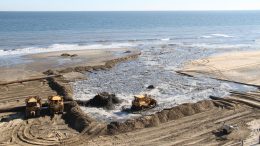Coastal beaches are dynamic systems. Wind, waves, and currents constantly move sand around, enlarging a beach here, narrowing one there. Storms make more drastic changes, sometimes washing away or depositing entire beaches.
When humans build houses, roads, hotels, and other structures on or near beaches, they put themselves in conflict with this dynamic nature. Communities trying to protect such infrastructure often employ a variety of methods to hold sand in place, including hard structures such as jetties and seawalls.
These don’t actually stop sand from moving, though. They just change where and how it does move, and they often enhance local erosion. Increasingly severe storms and sea-level rise caused by climate change are only making the problem worse.
Officials in many towns and cities have turned to another method: beach renourishment. This involves bringing in sand from elsewhere and adding it to eroded beaches. Beach nourishment only accounts for about 5% of the more than 55 billion tons of sand mined worldwide every year — a level of removal that threatens coastal ecosystems worldwide — but experts say its benefits are questionable and its potential for harm perhaps underestimated.
A Complex Issue
Since the first beach renourishment in New York in 1923, projects in 470 U.S. communities have used almost 1.7 billion cubic yards of sand, according to the National Beach Nourishment Database published by the American Shore and Beach Preservation Association.
The practice is also common in Europe, with a 2021 study reporting that the Netherlands uses an average of 12 million cubic meters of sand for nourishment annually (a cubic meter is roughly the size of a pickup truck bed, slightly larger than a cubic yard). Germany uses 1.9 million cubic meters annually, Spain about 10 million cubic meters, and Denmark 2.5 million, compared to about 16 million in the United States.
Some experts point out that beach nourishment projects help protect coastal infrastructure and restore beaches for tourism and can replace or create wildlife habitat. The city of Galveston, Texas, for example, credits a 1985 project with a tourism revival there. Another project on the island resulted in buildup of dunes along the seawall that provided additional protection and wildlife habitat.
But experts also warn that collecting and depositing sand for beach renourishment can damage complex ecosystems. Underwater sand is habitat for seagrass and marine animals such as sea stars, sea cucumbers, and conchs, and feeding grounds for rays, fish such as flounders, and sharks.
Many U.S. renourishment projects use sediment collected during regular dredging of ports and ship channels. The city of Galveston, for example, reports that many of its of 19 renourishment projects, representing more than 4.6 million cubic yards, used sediment from maintenance dredging of a ship channel at the island’s east end. Since this dredging is already happening, at least this practice avoids disturbing additional sites.
But dredging can significantly degrade water quality over large areas and for long periods of time, and the quality of dredged sand often differs substantially from that naturally on the beach. Changing the size and type of grains on a beach can affect the flora and fauna living in sand, and multiple studies have shown that changing sand characteristics affects nesting by sea turtles and birds.
For example, a long-term study by the Sanibel-Captiva Conservation Foundation in Florida found annual sea turtle hatching success on nourished beaches fell by about 20% on average compared to non-nourished ones. Another study, conducted by the Sea Turtle Conservancy, reported significant reduction in successful nesting by sea turtles following a renourishment project in Martin County, Florida, and noted that the width and flatness of the new beach left a higher percentage of nests prone to inundation during high tides. (Three years following the renourishment, nesting had returned to normal.)
Rather than bringing in sand from elsewhere, some projects use bulldozing to restructure beaches. Three months after a project in North Carolina bulldozed sand from the lower beach to build up dunes at the back beach, researchers recorded dramatically lower numbers of saltwater clams and sand and ghost crabs on the bulldozed segments. Sand crabs had failed to recover by midsummer, when they serve as the primary food for important surf fishes and some shorebirds. The study authors blame this failure on poor match in sand-grain size, high shell content in the sand, and extension of the project too far into the warm season.
According to a North Carolina Coastal Federation report, monitors have documented sea turtles prevented from nesting or even killed by bulldozing, and renourishment pipelines preventing hatchlings from reaching the sea. Nests can be buried as well, adds Kerri Allen, the organization’s coastal management director, and the noise and lights from a project can deter nesting females.
In addition, sand placed on a beach is eventually lost to the same forces that removed sand in the first place. That means renourishment must be constantly repeated — generally every three or four years. In an unfortunate coincidence, that’s about the time it takes natural systems on a renourished beach to recover, according to a study in the Journal of Coastal Research.
Most sand used for renourishment in the United States is mined legally, so at least here the practice doesn’t contribute to the worldwide problem of illegal sand mining. But that’s not true in other parts of the world. Stephen Leatherman, a professor at Florida International University — known as Dr. Beach and famous for his annual list of the world’s top 10 beaches — tells me armed guards once blocked him from a beach in Morrocco. Illegal miners were removing its white sand, which he says ended up on a formerly black sand beach in the Canary Islands.
Making It Better
The four authors of the 2022 book Vanishing Sands, all researchers and experts in geology and coastal sciences, suggest the need to rethink beachside development, which drives much renourishment.
“If no buildings crowded the shoreline, there would be no need for shoreline armoring, beach nourishment, or beach scraping,” the book stated. “The threats to the beach fauna and flora or the recreational quality of the beach would not exist. And there would be no erosion problem requiring mined replenishment sand. No buildings, no erosion problem.”
Extensive beachside development already exists on most of the world’s coastlines, of course, and preservation of sandy beaches is essential to protect this development and for tourism, a major contributor to coastal economies. Add in rising sea levels, and efforts to hold shorelines in place and protect infrastructure will likely intensify.
To many, beach renourishment seems less harmful than hardened structures such as seawalls and bulwarks. But that may not be the case. While beach monitoring studies are routinely required for U.S. beach nourishment projects, a 2005 review published in the journal BioScience reported that, at the time, 73% of them misinterpreted at least some of their results and more than half lacked rigorous support from evidence and analysis for their conclusions, often due to poor study design.
“The review was motivated by our observation that despite years of mandated monitoring of beach nourishment projects, our knowledge of the biological impacts remained poor,” says co-author Melanie J. Bishop, now at Macquarie University in Australia. “Sadly, our finding of major deficiencies in the majority of studies was what we suspected — that ecological monitoring was essentially a box ticking exercise, done to fulfill permitting obligations, but with little scientific rigor.”
She and co-author Charles H. Peterson (now deceased) suggested addressing these problems by improving permitting, monitoring, and mitigation for renourishment projects. Monitoring, for example, needs to be driven by clear goals, conducted by independent research organizations, and subject to peer review.
“Monitoring in and of itself does not make beach nourishment more or less harmful,” Bishop says. “Instead of requiring monitoring of each and every project as a box-ticking exercise, funds otherwise dedicated to monitoring may be better placed into a central pool used strategically to fund basic research that improves our understanding of how sandy beach ecosystems operate and respond to change.” The paper also recommended that state and federal permitting ensure compliance with the National Environmental Policy Act, which has yet to happen.
In North Carolina Allen says she’s seen improvement in the management of nourishment projects, partly due to stronger regulations at both the federal and state level, she says, and partly due to increased awareness, education, and oversight.
“Coastal residents are highly educated when it comes to issues like these, and they are the first to call when they see something that is out of place,” she says. “These residents will call an advocacy group, like the Coastal Federation, and we will call the regulatory agency and local government reps to make sure that all the rules are being followed. We also review permit applications when they are sent out for public notice to ensure regulations are being followed and to remind the agencies that someone is watching.”
The North Carolina organization also has recommended that permits require projects to avoid operations during certain months and that nourishment sand closely match the beach’s original grain size, color, and shell and silt content.
“Conducting these projects well outside of nesting season is key,” Allen says, “as is detailed analysis looking at the composition of the placement material to make sure it is compatible. If both the size and composition don’t match what is on the beach, it can exacerbate erosion and also disrupt imprinting for sea turtle hatchlings. It’s well-documented that sea turtle hatchlings return to the beach where they hatched to lay a nest, and a fairly mainstream understanding for how that works is that hatchlings imprint on sand while making their way to the water.”
Allen adds that it is important to note that, without nourishment projects, sea turtles in some places would not have a beach to nest on. “And beaches with hardened seawalls, groins, jetties, sandbags, and such are far worse for sea turtle nesting than nourished ones,” she says. “Like most coastal management issues, there is no cut and dry ‘right’ or ‘wrong’ solution.”
The United Nations Environment Programme’s 2022 report “Sand and Sustainability,” which addressed the larger issues of global sand use, also recommended using sand that is as similar as possible to the original, as well as from a location that keeps the sand in the larger ecosystem.
UNEP further urged using nature-based (green) engineering over built or gray engineering (seawalls, bulwarks, and the like):
“Sand has key functions in nature and drives important natural processes,” the report stated. “Nature-based solutions make intentional use of these natural processes to strengthen engineering performance and preserve certain ecosystem services linked to sand. Replacing grey engineering with green engineering is the ‘no regrets’ option. It is natural and environmentally friendly, reduces the use of concrete, can be done in collaboration with local communities, requires low (if any) maintenance, has aesthetic value, stores carbon, supports biodiversity and usually is cost effective.”
(Making concrete itself requires significant amounts of sand.)
With climate change increasing the natural forces that continually move sand around on the world’s coasts and oceans, beach renourishment is unlikely to go away anytime soon. But at the very least, we can start doing it better.
“It’s easy to assert that there shouldn’t be development on barrier islands and that managed retreat is the only responsible option long-term,” Allen says. “But the reality is, these homes and businesses and infrastructure exist in these dynamic habitats, and municipalities have a responsibility to serve their residents as best they can. We work hard to get coastal leaders and residents thinking about long-term solutions, but in the meantime, we’re all just trying to do the best we can with the information we have.”
That said, Allen admits beach nourishment is probably not the best solution. “But do I wholeheartedly believe it’s the far better alternative to hardened structures? Yes. So we have to continue to weigh the pros and cons of all of these methods and continue to support and fund research that may yield an even better alternative.”

Previously in The Revelator:
Coastal Restoration: Recycled Shells and Millions of Larvae — A Recipe for Renewed Oyster Reefs





